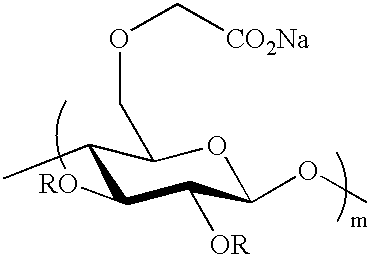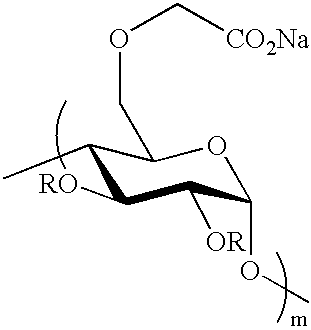Crosslinked polysaccharide, obtained by crosslinking with substituted polyethylene glycol, as superabsorbant
a polysaccharide and crosslinking technology, applied in the field of crosslinked polysaccharides, can solve the problems of not being biodegradable, and no evidence that such compounds would be biodegradabl
- Summary
- Abstract
- Description
- Claims
- Application Information
AI Technical Summary
Benefits of technology
Problems solved by technology
Method used
Image
Examples
example 2
Preparation of 1,8-dichloro-3,6-dioxaoctane (Triglycol Dichloride 3b)
[0105] 10.0 g (67 mmol) of triethylene glycol were treated as example 1 with 22 ml (4 eq.) of pyridine and 19 ml (4 eq.) of thionylchloride to give 8.8 g (62% yield) of the dichloride as a yellow oil, used without further purification. Infrared spectroscopy showed the absence of hydroxyl band.
[0106] IR (neat): 2962, 2870, 1452, 1123, 747, 666 cm.sup.-1.
example 3
Preparation of 1,11-dichloro-3,6,9-trioxaundecane (Tetraglycol Dichloride 3c)
[0107] 10.0 g (52 mmol) of tetraethylene glycol were treated as example 1 with 17 ml (4 eq. ) of pyridine and 15 ml (4 eq.) of thionylchloride to give 7.2g (61% yield) of the dichloride as a yellow oil, used without further purification. Infrared spectroscopy showed the absence of hydroxyl band.
[0108] IR(neat): 2951, 2870, 1459, 1118, 746, 665 cm.sup.-1.
Comparaison of Divinylsulfone and Triglycol Dichloride as Crosslinkers to Obtain Starch-based Superabsorbents (FIGS. 1, 2)
example 4
Preparation of a Carboxymethylstarch, Crosslinked with 0.62% w / w Divinylsulfone: Compound 11a
[0109] 2.0 g (12.3 mmol) of wheat starch A ( Supercell 1201-C, ADM / Ogilvie) was suspended in 40 ml of deionized water. Under stirring, 3.5 ml 30% NaOH (26.3 mmol, 2.1eq.) was added dropwise and the solution stirred at room temperature for 1 hour. Chloroacetic acid (1.16 g, 12.3 mmol, 1 eq), dissolved in 10 ml of deionized water and neutralized with 1.6 ml 30% NaOH (12.3 mmol, 1 eq.) was added dropwise and the reaction mixture was heated at 70.degree. C. for 24 hours. At room temperature, 12 mg (0.62 weight %) of divinylsulfone dissolved in 10 ml acetone, was added dropwise and the solution was stirred for 2 hours. The polymer was precipitated with 100 ml of methanol, triturated in a blender, washed with 3 portions of 60 ml methanol, filtered and dry at 60.degree. C. for 16 hours to give 1.97 g of a white solid. The solid was grinded with a coffee grinder to get compound 11a as a fine powder....
PUM
| Property | Measurement | Unit |
|---|---|---|
| temperature | aaaaa | aaaaa |
| temperature | aaaaa | aaaaa |
| temperature | aaaaa | aaaaa |
Abstract
Description
Claims
Application Information
 Login to View More
Login to View More - R&D
- Intellectual Property
- Life Sciences
- Materials
- Tech Scout
- Unparalleled Data Quality
- Higher Quality Content
- 60% Fewer Hallucinations
Browse by: Latest US Patents, China's latest patents, Technical Efficacy Thesaurus, Application Domain, Technology Topic, Popular Technical Reports.
© 2025 PatSnap. All rights reserved.Legal|Privacy policy|Modern Slavery Act Transparency Statement|Sitemap|About US| Contact US: help@patsnap.com



